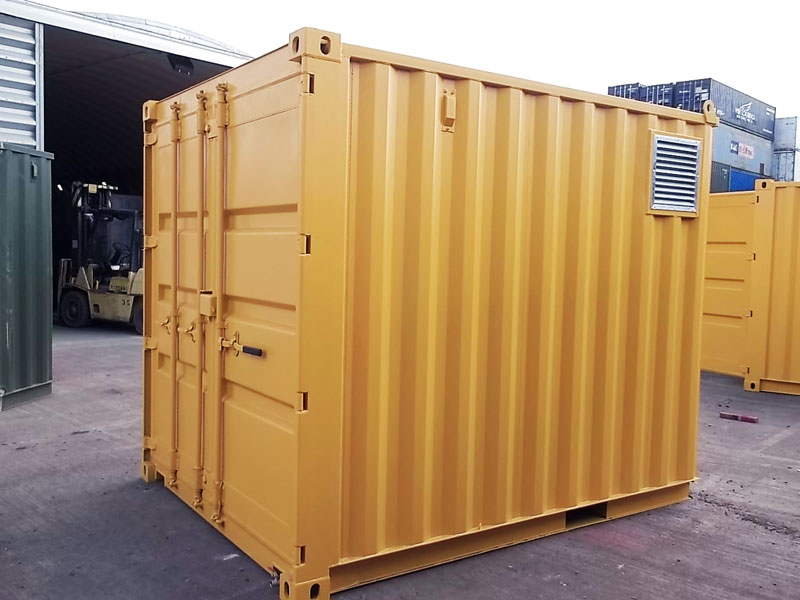
Chemical Storage, COSHH Storage And Bunded Storage
Our storage containers are fire resistant, leak proof, and heavy duty, making them perfect for COSHH storage, bunded storage, and the storage of chemicals. They can also be customised as per your specifications.
What Are Our COSHH Stores?
Bunded COSHH Stores are “Sub-Floor” Bunded Chemical Stores. They provide safe and secure storage of hazardous substances or flammable materials that must be stored in compliance with COSHH (Control of Substances Hazardous to Health) regulations. That means they must store hazardous substances as well as pesticides or fertilisers in a way that ensures the health and safety of humans and animals, and protects environmental welfare.
Our COSHH Stores are perfect for this. They are converted from ISO Shipping Containers similar to our Bunded Chemical Stores, but have a sub-floor bund with a raised mesh floor. This avoids the potential trip hazard of an additional step and allows any hazardous or flammable materials to drain into the sump below the pedestrianised area. This protects users of the container from any harm from any hazardous substances stored within the COSHH store. Our COSHH Stores are also lockable for adherence to security policies.
Key Features Of Our COSHH Stores
Bunded COSHH Stores are “Sub-Floor” Bunded Chemical Stores. They provide safe and secure storage of hazardous substances or flammable materials that must be stored in compliance with COSHH (Control of Substances Hazardous to Health) regulations. That means they must store hazardous substances as well as pesticides or fertilisers in a way that ensures the health and safety of humans and animals, and protects environmental welfare.
Our COSHH Stores are perfect for this. They are converted from ISO Shipping Containers similar to our Bunded Chemical Stores, but have a sub-floor bund with a raised mesh floor. This avoids the potential trip hazard of an additional step and allows any hazardous or flammable materials to drain into the sump below the pedestrianised area. This protects users of the container from any harm from any hazardous substances stored within the COSHH store. Our COSHH Stores are also lockable for adherence to security policies.
Key Features Of Our COSHH Stores
Key Features Of Our COSHH Stores
- Sub-floor bund (no step)
- Drain valve (from sumped area)
- High-security storage
- Vandal-proof vents
- Removable mesh flooring
- HSE pesticide storage-compliant
- Available in any colour
- 10ft, 20ft, 30ft and 40ft lengths
- Optional shelving, racking, ramps and electrics
For a full breakdown of our COSHH Store features and specifications, download our product brochure.
What is COSHH?
COSHH regulations require employers to safely store and control substances that are hazardous to health. This is to ensure the health and safety of employees. There are various measures that can be taken to minimise the risks posed by hazardous substances, including:
- Finding out what health hazards pose a risk to employees
- Deciding how to prevent harm to employee health
- Providing control measures to reduce harm to employee health
- Ensuring said control measures are used by all employees and other on-site visitors
- Keeping all control measures in good working order
- Providing information, instructions, and training to employees and other on-site visitors
- Providing monitoring and health surveillance in appropriate cases
- Planning for emergencies
There are many businesses that use substances, or products that are mixtures of substances, that could cause harm to employees, contractors, and on-site visitors or off-site people. These substances – including common substances that may also be harmful, such as paint, bleach, or dust from natural materials – should be carefully controlled and stored in COSHH stores.
How Should COSHH Items Be Stored?
COSHH regulations dictate hazardous substances should be stored in such a way as to minimise their risk and ensure the health and safety of employees. To do so requires a dedicated COSHH store or storage cabinet that is:
- Safe and secure (this means they are fire resistant, leak proof, and lockable to prevent thefts or accidents)
- Kept separate from process areas
- Located close to washing facilities
- Kept organised and well maintained (for example, substances should be clearly labelled with correct signage used, and those substances that have passed their use by date should be disposed of appropriately)
- Well ventilated and well lit
Our chemical stores meet the above criteria and are ideal for the storage of chemicals and other hazardous substances.
What Are COSHH Substances?
COSHH covers substances that are hazardous to health including:
- Hazardous chemicals
- Hazardous materials
- Products containing chemicals
- Fumes
- Dust
- Vapours
- Flammable substances and flammable liquids
- Mists
- Nanotechnology
- Gases and asphyxiating gases
- Biological agents
- Germs that cause diseases such as leptospirosis and germs used in labs
Hazardous substances refer to individual chemical substances as well as preparations that include a mixture of one or more chemical substances such as paints, solvents, cleaning materials, pesticides, and gas cylinders. As well as using chemicals, some manufacturing processes may also create substances which could be harmful to employees, contractors and other people. COSHH regulations do not cover lead, asbestos and radioactive substances – these are subject to their own specific regulations.
What Is Classed As Hazardous ?
A hazardous substance or dangerous substance is one which features at least one inherent hazardous property such as flammability, explosiveness, corrosiveness, or toxicity.
This may mean that it has the potential to result in long-term damage to a person’s health, including injury to skin, nose, mouth, eyes, internal organs such as the lungs, genes, and the central nervous system. There are three main ways by which a person can be affected by a harmful substance – inhalation, ingestion, or absorption of an irritant through the skin.
Alternatively, the substance may pose a risk of combustion or explosion or due to its ability to oxidise. It’s important to note that although there is a wide range of substances that have the potential to cause harm, when used and stored properly in line with the appropriate protocols, they rarely do.
How Are Businesses Responsible For COSHH?
In order to ensure compliance, employers must assess risks related to COSHH substances used within the workplace and provide safe storage in line with regulations.
They then need to determine measures to prevent or adequately control exposure. Plus, they should be aware of the hierarchy of control measures that must be followed in relation to the risk associated with a specific substance.
In summary, chemical storage should be in accordance with the manufacturers instructions and safety data sheets. The COSHH store should include sufficient space, be organised and tidy, contain good lighting and be well ventilated. It should also have a floor that is resistant to chemical damage and is easy to clean and maintain. Our COSHH Stores meet these requirements.
Ultimately, the organisation or employer is responsible for the implementation of COSHH, with obligations including:
- Assessment
- Control
- Monitoring
- Protecting
- Training
- Reporting
Assessment
To identify potential hazards, businesses must complete regular COSHH and risk assessments. These assessments concentrate on the hazards and risks posed by the use or production of specific substances, and include the following steps:
- Identify potential hazards
- Identify who could be harmed and how
- Conduct an evaluation of the risks
- Establish precautionary measures including signage
- Record findings
- Implement changes
- Review and evaluate
Depending on the type of COSHH substance and its properties, the assessment should take into consideration work circumstances including safe handling, storage, transportation of hazardous substances, and appropriate waste removal.
Control
COSHH requirements mean that employers have a responsibility to control any substances that may be hazardous to health. If it is not possible to completely prevent exposure by using a different substance, measures could include checking for damage or leaks regularly , ensuring that damaged containers, storage lockers or storage cupboards are replaced immediately and making sure that any spills are cleaned up immediately.
Waste should also be segregated from other substances and labelled appropriately. Furthermore, it is essential for businesses to be aware of the applicable Workplace Exposure Limits (WEL’s) for the substances used. This refers to the limits of legal maximum exposure and is dependent upon the type of hazardous substances used for the work activity.
Monitor
Businesses are legally obligated to monitor and maintain the control measures that they have put in place as part of the COSHH assessment. This may include health surveillance, which refers to a regular system of ongoing health checks.
This approach is effective at ensuring any ill health is discovered early, evaluating risk, and reinforcing training and education. Moreover, health surveillance provides a platform for employees to raise concerns about the use of hazardous substances in the workplace. Depending on the type of business, this may or may not be a legal requirement.
Protect
Businesses have a duty to protect workers from harm and to reduce the risks associated with the substances required for the work activity.
An example of a protective measure is the use of PPE (Personal Protective Equipment). Although this can add an extra layer of safety, it should be considered the last line of defence. The use of some hazardous substances may also require employees to wear Respiratory Protective Equipment.
Training
It is imperative for companies to ensure that all employees understand the necessary precautions related to the use, storage, and transportation of COSHH substances.
As well as being aware of which substances are hazardous, it is also important for workers to know why they are hazardous and what damage they could cause. COSHH training can go some way to ensure that control measures are maintained, but it needs to be regularly updated to ensure that it’s in line with current guidelines.
Report
Businesses are also required to report and record accidents, spillage and breakages in line with the Reporting of Injuries Diseases and Dangerous Occurrence Regulations (2015). Most incidents should be reported online, but there is a telephone service for reporting fatal and specified injuries only.
